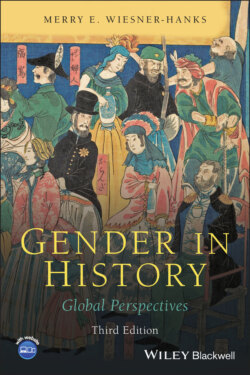Читать книгу Gender in History - Merry E. Wiesner-Hanks - Страница 10
World and Global History
ОглавлениеThe subtitle of this book, “global perspectives,” highlights another development in history over the past half century: the growth of world, global, and other types of history that use a wide spatial lens. Until the last half of the twentieth century, most professional history – that is, history written by people trained at universities – focused on nation-states, and especially their political and military history. But during the 1960s, scholars and teachers began to challenge nationally organized histories. In North America, area studies programs at universities increasingly trained people to study many parts of the world, some professional historians began to write works with a broad scope, and college instructors and high school teachers created courses in world history. In Europe, the study of diplomacy gradually widened into imperial, international, and what was termed “overseas” history. Beginning in the 1980s, scholars in Asia, Africa, and Latin America critiqued much existing world and international history as overly centered on Europe, and posited different centers or called for a more polycentric world history. The 1990s brought other new directions, including transnational history, Atlantic World history, borderlands histories, connected history, world systems history, diasporic history, and many others. Some historians began to describe their field as global history, to reflect the increasing integration of world regions into a single system through globalization, though other historians (including me) see world and global history as largely the same.
Like women’s and gender history, world and global history have had their own debates and controversies about conceptualizations, inclusion, and scope. Courses often began as ones on various “civilizations” around the world considered separately, which tended to promote a binary model of “the West and the rest,” with an overemphasis on the West that in the 1980s came to be labeled “Eurocentrism.” Gradually many of those teaching world history rejected that model in favor of one that emphasized connections, interactions, and multipronged comparisons. Today world historians tend to de-emphasize individual nations or civilizations, and focus instead on regions defined differently, including zones of interaction, or on the ways in which people, goods, and ideas moved across regions through migration, conquest, and trade. Most world historians think that history should be studied on a range of chronological and spatial scales, including, but not limited to, very large ones.
Until about 2000, there was little connection between the history of women, gender, and sexuality and world/global history. In part this was because both of these fields developed at the same time as revisionist interpretations arguing that the standard story needed to be made broader and much more complex. Each disrupted a topic that was seen as the natural and proper focus of historical scholarship: heterosexual man on the one hand, and the nation on the other. Thus both have been viewed by those hostile or uninterested as “having an agenda.” Both concentrated on their own lines of revision, so did not pay much attention to what is going on in the other. In addition, world/global history tended to focus on large-scale political and economic processes carried out by governments and commercial elites. Most of the people involved were men, but how gender shaped their experience was not evaluated, as the emphasis was on material rather than cultural factors: ships, guns, trade goods, factories, railroads, satellites. Women’s history also initially had a strong materialist wing, with many studies of work and political movements, but over the past several decades it has paid more attention to cultural issues, representation, and meaning, which has also characterized the history of sexuality. Historians of women, gender, and sexuality have tended to have a narrower range of focus, choosing to study individuals, families, circles of friends, and other small groups, and have been worried that these would get lost in narratives that emphasize impersonal processes. Their analyses have generally stayed within one nation, and many within one region or city.
This lack of intersection is beginning to change, however, which is what makes this book possible. It is based on hundreds of articles and books that focus on gender and related topics in different parts of the world, and increasing numbers that make comparisons, evaluate exchange and interaction, study borderlands and migration, and otherwise incorporate theory and methods that also characterize world/global history. There was very little of this when I published the first edition of this book 20 years ago, but the amount of scholarship that is both gendered and global grows steadily. This scholarship is based on new research, and also on reevaluating older research with an eye to assumptions about gender that are incorrect or misleading. For example, the Supreme Being in the Maa language of the Maasai and other groups in East Africa is known as Enkai, a feminine singular noun, and envisioned as a woman. Christian missionaries and European colonial officials generally referred to Enkai instead as “he” when writing in English, as this fit with Christian understandings of what Supreme Beings should be. Doing comparative or world history often means relying on translations – there is simply no way to know all the languages of even a part of the world – but translation always involves choice, and in this case the choice was wrong. So newer scholarship about the Maasai, and about encounters between the Maasai and Europeans, corrects Enkai’s gender. Feminist world historians emphasize the importance of finding translations and using secondary studies that are more accurate and thus culturally sensitive, especially for things as central as gender (or Supreme Beings).
Before delving into what the new scholarship on gender in world history reveals, it is valuable to look at some of the key issues that gender historians have wrestled with in more detail. These have shaped the path historians and scholars in other fields have taken as they approach the past.
